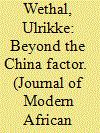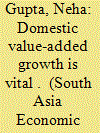| Srl | Item |
| 1 |
ID:
159556


|
|
|
|
|
| Summary/Abstract |
China has become a significant contributor to closing Africa's infrastructural gap, but Chinese companies are repeatedly criticised for not involving local businesses in their operations, and for isolating themselves from the socio-economic environment. Can this be attributed to ‘typical Chinese business practice’? This article employs linkage theory to examine the weak domestic backward linkages in Chinese-led construction projects in Mozambique. The analysis shows that while Chinese companies do not involve Mozambican businesses in their activities to any extent, this cannot be attributed solely to any ‘Chinese business model’. It is a consequence of weak local industrial capabilities, fragile social infrastructure and a liberal policy environment not conducive to the creation of domestic backward linkages in Chinese-led construction projects.
|
|
|
|
|
|
|
|
|
|
|
|
|
|
|
|
| 2 |
ID:
147896


|
|
|
|
|
| Summary/Abstract |
Gains under the global value chains (GVCs) depend on how much of a country’s domestic value added (DVA) is passing onto other countries. However, India’s manufacturing sector is found to be hollowing out, that is, its DVA growth is declining. This article estimates the linkages of manufacturing sector into GVCs, focusing on machinery and textiles industries. It measures foreign value added in exports and gains under GVCs using intercountry input–output tables of OECD–WTO Trade in Value Added (TiVA) database (2015). TiVA shows a decline in India’s share of DVA exports in its gross exports. However, India has ‘net gains’ from linking into GVCs in the two industries as the ratio of forward linkages to backward linkages is greater than one. This indicates that value-added exports are greater than value-added imports. Thus, India has enough potential to compete with other countries in the upper ends of value chains in both its machinery and textiles industries.
|
|
|
|
|
|
|
|
|
|
|
|
|
|
|
|